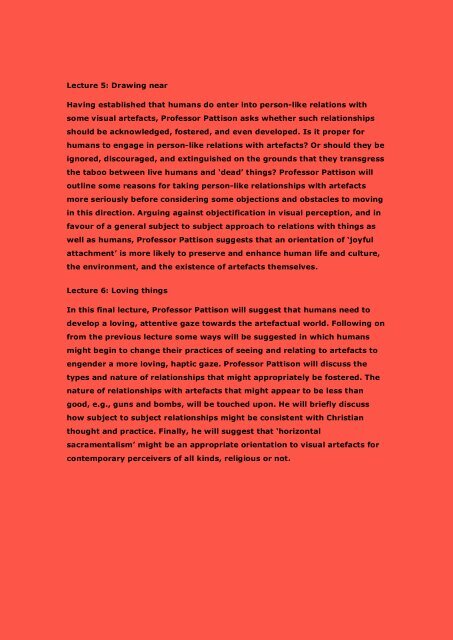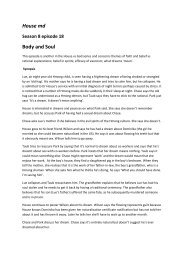Professor Stephen Pattison's Gifford Lectures on
Professor Stephen Pattison's Gifford Lectures on
Professor Stephen Pattison's Gifford Lectures on
Create successful ePaper yourself
Turn your PDF publications into a flip-book with our unique Google optimized e-Paper software.
Lecture 5: Drawing near<br />
Having established that humans do enter into pers<strong>on</strong>like relati<strong>on</strong>s with<br />
some visual artefacts, <str<strong>on</strong>g>Professor</str<strong>on</strong>g> Pattis<strong>on</strong> asks whether such relati<strong>on</strong>ships<br />
should be acknowledged, fostered, and even developed. Is it proper for<br />
humans to engage in pers<strong>on</strong>like relati<strong>on</strong>s with artefacts? Or should they be<br />
ignored, discouraged, and extinguished <strong>on</strong> the grounds that they transgress<br />
the taboo between live humans and ‘dead’ things? <str<strong>on</strong>g>Professor</str<strong>on</strong>g> Pattis<strong>on</strong> will<br />
outline some reas<strong>on</strong>s for taking pers<strong>on</strong>like relati<strong>on</strong>ships with artefacts<br />
more seriously before c<strong>on</strong>sidering some objecti<strong>on</strong>s and obstacles to moving<br />
in this directi<strong>on</strong>. Arguing against objectificati<strong>on</strong> in visual percepti<strong>on</strong>, and in<br />
favour of a general subject to subject approach to relati<strong>on</strong>s with things as<br />
well as humans, <str<strong>on</strong>g>Professor</str<strong>on</strong>g> Pattis<strong>on</strong> suggests that an orientati<strong>on</strong> of ‘joyful<br />
attachment’ is more likely to preserve and enhance human life and culture,<br />
the envir<strong>on</strong>ment, and the existence of artefacts themselves.<br />
Lecture 6: Loving things<br />
In this final lecture, <str<strong>on</strong>g>Professor</str<strong>on</strong>g> Pattis<strong>on</strong> will suggest that humans need to<br />
develop a loving, attentive gaze towards the artefactual world. Following <strong>on</strong><br />
from the previous lecture some ways will be suggested in which humans<br />
might begin to change their practices of seeing and relating to artefacts to<br />
engender a more loving, haptic gaze. <str<strong>on</strong>g>Professor</str<strong>on</strong>g> Pattis<strong>on</strong> will discuss the<br />
types and nature of relati<strong>on</strong>ships that might appropriately be fostered. The<br />
nature of relati<strong>on</strong>ships with artefacts that might appear to be less than<br />
good, e.g., guns and bombs, will be touched up<strong>on</strong>. He will briefly discuss<br />
how subject to subject relati<strong>on</strong>ships might be c<strong>on</strong>sistent with Christian<br />
thought and practice. Finally, he will suggest that ‘horiz<strong>on</strong>tal<br />
sacramentalism’ might be an appropriate orientati<strong>on</strong> to visual artefacts for<br />
c<strong>on</strong>temporary perceivers of all kinds, religious or not.














